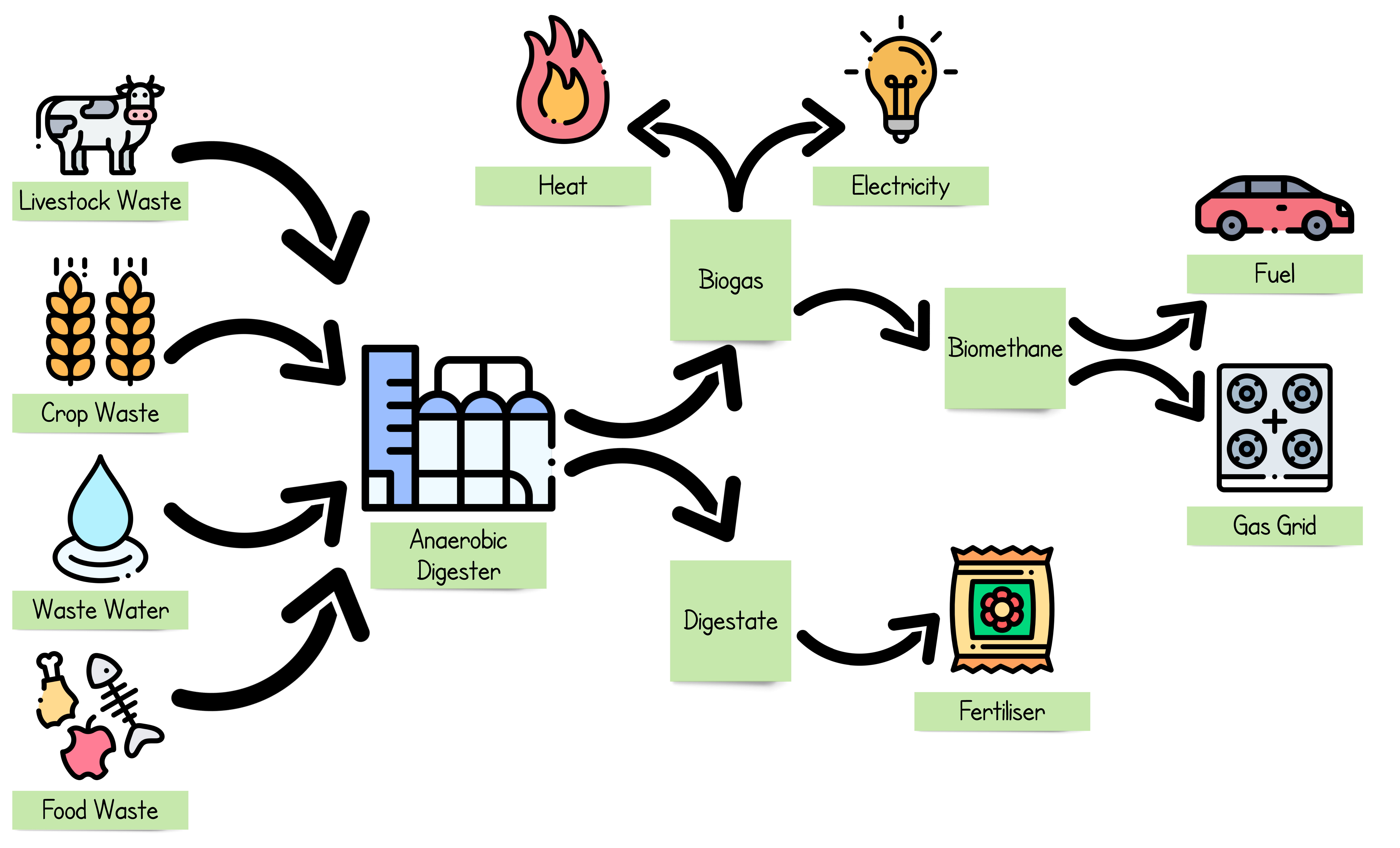We sell and supply anaerobic digesters. The system is a carbon-neutral advanced waste management solution, allowing you to save on living costs. The key benefit of this unit is the produced nitrogen and phosphorus rich liquid fertilizer. A additional bonus is the biogas produced.
You can simply throw in any decomposable organic material into the digester and it will provide you with much organic liquid fertilizer and some biogas. Biogas is renewable energy and can be used as a Renewable Natural Gas (RNG) alternative. Ideal for cooking gas and hot water systems. You can even power a generator for electricity or run a motor vehicles similar to existing LPG/autogas cars.
A home biogas solution is an outstanding
option for off-grid living, but we'd recommend
them for every a family house, villa, resort, backyard, hotel,
restaurant, fresh good grocery store, farm, smart home, and smart
estate. We are confident residential, industrial or businesses
might be interested. It's basically FREE
fertilizer and FREE energy. We offer various size hard design digesters! Prior to this we
used a cost-effective soft design (similar to HomeBiogas.com),
but we don't recommand a soft design anymore - the membrane can
tear, and the support structure is weak and not suitable for
Australian conditions. The hard design solution is enclosed in a
greenhouse to maximize efficiency and reduce process (aka
retention) time. This design uses a stainless steel
frame, sink and outlet - instead of a plastic or
nonexistent frame like the various soft design soluitons out
there - a hard design ensures a long-lasting design, protected
from the elements such as weather and animals if used
outdoors. Within the hard design is the traditional soft-design
membrane. We'd recommend the system is used outdoors for warm/hot
climate locations (e.g. Queensland and Darwin). For colder
climates (e.g. Tasmania) we recommend the system is used indoors
with the heater accessory we offer (installed within the
digester). For areas like NSW - either option will likely be
sufficient.

Biogas is a mixture of gases, primarily consisting of methane aka biomethane (50-80%), carbon dioxide (5-50%), hydrogen (0-1%), hydrogen sulphide (0-3%), and oxygen (0-2%) produced from organic materials such as agricultural waste, manure, municipal waste, plant material, sewage, green waste and food waste.
It should be noted that hydrogen sulphide has a rotten egg smell, and exposure is particularly dangerous for two reasons: concentrations of 800 ppm (even for just a short time) can be fatal; a person can become desensitized to the smell of from prolonged low-level exposure (meaning a person may inadvertently become unaware of exposure to concentrations that could be potentially hazardous). It is for these reasons the systems we provide include a desulfurizer (aka scrubber) to remove impurities (and therefore smell) such as hydrogen sulphide. This scrubber contains iron oxide desulfurizer pellets. We'd recommand replacing it often (perhaps every 3 months) as a extra precaution for safety.
It is interesting to note that meat-eating (aka carnivores/omnivores) animals or humans will have pathogens, which increases digester processing/retention time to kill the pathogens. In short - a good biogas digester mimics a cows gut, so food waste, green waste and manure from herbivore animals are likely the best sources of feed for a biogas digester. All that said, meat and fish products can be fed into the system with low retention time and kill 99% of pathogens, when used in warm/hot climates or in cold climates with internal digester heater.
Greenhouse-based Solution (Hard Design)
Ideal if you want a very robust design for long-term use. See below accessory options such as biogas stove double burner, 1.5kW generator, and hot water system.

Hard Design Specifications
- Postage Weight: 130kg
- Dimensions: 1.95(L)x0.98(W)x1.65(H)m
- Volume: 3.4m³
- Bag max pressure: 30kPa
- Digester/Fermentation Volume: 1.7m³
- Gas Storage Volume: 1m³
- Fertilizer Production: 80% of the input
- Biogas Production: 2m³/day or higher
- External Design: Greenhouse with Stainless Steel Frame/Sink/Outlet
- Included accessories: Pressure Gauge, 10m Hose, Hose Fittings, Booster Pump, Filter/Desulfuizer/Scrubber
Hard Design Maximum Treating Capacity
- Rotting Vegetables: 65kg/day
- Cow/Horse manure: 60kg/day
- Pig manure: 45kg/day
- Chicken manure: 26kg/day
- Kitchen Food Waste: 25kg/day
- Grass Clippings: 18kg/day
NOTE: The organic material above can be either single material or mixed materials.
Common Specifications
- Output (depending on organic material and suitable temperatures):
- Organic Liquid Fertilizer: 80% of raw input!
- Biogas: 2m³/day or higher (i.e. about 4-6 hours/day of cooking gas for one burner)
- Internal Membrane Design: Anti-aging, Acid and Alkali Resistant, Rodent Resistance, Fire Retardant Properties
- Minimum Ambient Temperature: 10℃
- Expansion Options: Yes - multiple systems can be connected together
- Maintenance Level: Easy (DIY)
- Safety Level: Safe (no leaks, testers available if wanted)
- Install Level: Easy (DIY possible)
Accessory Options (AUD$, ex GST)
- $1954 - Biogas Generator (input biogas: 1.05m³/hr, output: 240Vac@50Hz 1.5kW)
- $925 - Food Waste Shredder (input: 240Vac@50Hz, capacity: 20L)
- $255 - Biogas Hot Water System (input biogas: 1.7-2.6m³/hr, output: 6L/min, 25-500kPa, 60℃)
- $212 - Electric Heater installed within for cold climates (input: 240Vac@50Hz)
- $195 - Biogas Storage Bag (2m³)
- $76 - Biogas Stove Double Burner (input biogas: 0.45m³/hr per burner)
- $52 - Biogas Stove Single Burner (input biogas: 0.45m³/hr)
- $28 - Biogas Lamp (input biogas: 0.07m³/hr)
- $98 - Hose Fittings (including 10m hose, pressure gauge, and hose fittings)
- $95 - Booster Pump (input: 240V@50Hz 20W)
- $12 - Filter/Desulfurizer/Scrubber - replace often (ideally every 3 months)
FAQ
I have a compost - is the liquid fertilizer better?
Yes - it's organic and proven to provide better yield for crops. You can think of a biogas digesters and a advanced compost system. You can also throw meat and fish into the digester unlike a typical compost. The produced fertilizer from the unit is rich in nitrogen, phosphorus, potassium, calcium, magnesium, sufur, which are all important to plant growth. It also has other trace elements such as zin, copper, manganese which are required in small quantities for plant growth.
Better still - 80% of the input will converted to this organic liquid fertilzer.
Can I grow plants to feed the system?
Yes - and plants are a renewable source. We'd recommend they are shredded before putting into the digester for optimal performance (avoid digestion).
Do larger options exist?
Yes - we do offer larger size systems, such as 15m³ (including larger generators). However you can join smaller systems together. The benifit of using a larger system over a few smaller ones is that you don't need to feed the units as often. However the advanaged of smaller units, is you can expand your system over time, saving on initial large capital cost.
How do I start my biogas digester?
A biogas digester is best started with cow dung, which naturally contains a mix of microorganisms necessary for the biogas production process.
Can I use an existing LPG equipment (e.g. stove, hot water system, generator)?
No - but you can use biomethane with a traditional LPG equipment.
Does the biogas hot water system water pressure match a typical home LPG hot water system?
The above 3.4m³ provides about half the flow rate and half the water pressure of a typical LPG hot water system. But if you join two of these systems together it should achieve the flow rate and water pressure of typical home. However this means more organic material to feed the digester.
Can I compress biogas?
Yes and no - in theory you can use a compressor to compress biogas into empty LPG bottles, however it's not something we offer at this stage nor recommand. We'd suggest the first step is to refine biogas into biomethane.
Do we offer conversion kits from biogas to biomethane?
Not at this stage sorry. The equipment to refine/filter biogas to pure biomethane is complex and expensive. The key benefit of this unit is the nitrogen and phosphorus rich liquid fertilizer. The biogas is just a bonus output.
Can I use human manure?
Yes - if regulations allow. The above 3.4m³ system can take up to 32kg/day. However at this stage, human manure is not approved for use in a anaerobic digester under Australian regulations.
What can't I put into the digester?
You can't insert non organic material, and shouldn't insert material that is hard to decompose like wood chips and bones.
Biogas Digesters & Renewable Energy for Grantville – Our Clients: Big Brands & Small Businesses


















































































































































Biogas Digesters & Renewable Energy for Grantville – Amazing Customer Testimonials
COLETEK proved to be the perfect choice to help us kick our project off. Their analysis of the problem we presented with them with, and their suggestions for the most efficient and effective way to achieve a solution prevented us wasting time and money heading down the wrong path. I'd recommend COLETEK without any reservations.

As a leading technology solutions provider we carefully choose our partners to outsource some of our projects. Black Box has partnered with COLETEK in delivering numerous projects. Every single time they have delivered work of highest standard and meet our project deadlines. It's a pleasure to work with COLETEK team headed by Luke and hope to work on many more projects in the future.



